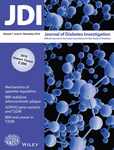Alendronate improves fasting plasma glucose and insulin sensitivity, and decreases insulin resistance in prediabetic osteopenic postmenopausal women: A randomized triple-blind clinical trial
Authors
Affiliations
Abstract
Aims/introduction: Postmenopausal women receive bisphosphonates for osteoporosis treatment. The effect of these medications on developing diabetes mellitus in prediabetic patients is yet to be investigated. We aimed to determine the effect of alendronate on plasma glucose, insulin indices of postmenopausal women with prediabetes and osteopenia.
Materials and methods: The present triple-blind randomized controlled clinical trial included 60 postmenopausal women, aged 45-60 years. All patients were vitamin D sufficient. They were randomly enrolled in intervention (70 mg/week alendronate for 12 weeks) and control (placebo tablet per week for 12 weeks) groups. The morning 8-h fasting blood samples were collected at the baseline and follow-up visits to measure the fasting plasma glucose (mg/dL), insulin and hemoglobin A1c (HbA1c). Plasma glucose and insulin concentration were measured 30, 60 and 120 min after the glucose tolerance test. The Matsuda Index, homeostasis model assessment of insulin resistance, homeostasis model assessment of β-cell function and the area under the curves of glucose and insulin were calculated.
Results: The mean (standard deviation) fasting plasma glucose (102.43 [1.46] mg/dL vs 94.23 [1.17] mg/dL, P = 0.001), 120-min insulin concentration (101.86 [15.70] mU/L vs 72.60 [11.36] mU/L, P = 0.026), HbA1c (5.60 [0.06]% vs 5.40 [0.05]%, P = 0.001), homeostasis model assessment of insulin resistance (3.57 [0.45] vs 2.62 [0.24], P = 0.021) and Matsuda Index (7.7 [0.41] vs 9.2 [0.4], P = 0.001) significantly improved in the alendronate-treated group. There were more statistically significant reductions in fasting plasma glucose (-8.2 [8.63] mg/dL vs -2.5 [14.26] mg/dL, P = 0.002) and HbA1c (-0.2 [0.23]% vs -0.09 [0.26]%, P = 0.015) observed in the alendronate-treated group than the placebo group during the study course, respectively.
Conclusions: Administration of 70 mg/week alendronate improves fasting plasma glucose, HbA1c and insulin indices in postmenopausal women.
Keywords: Alendronate; Menopause; Prediabetic.

